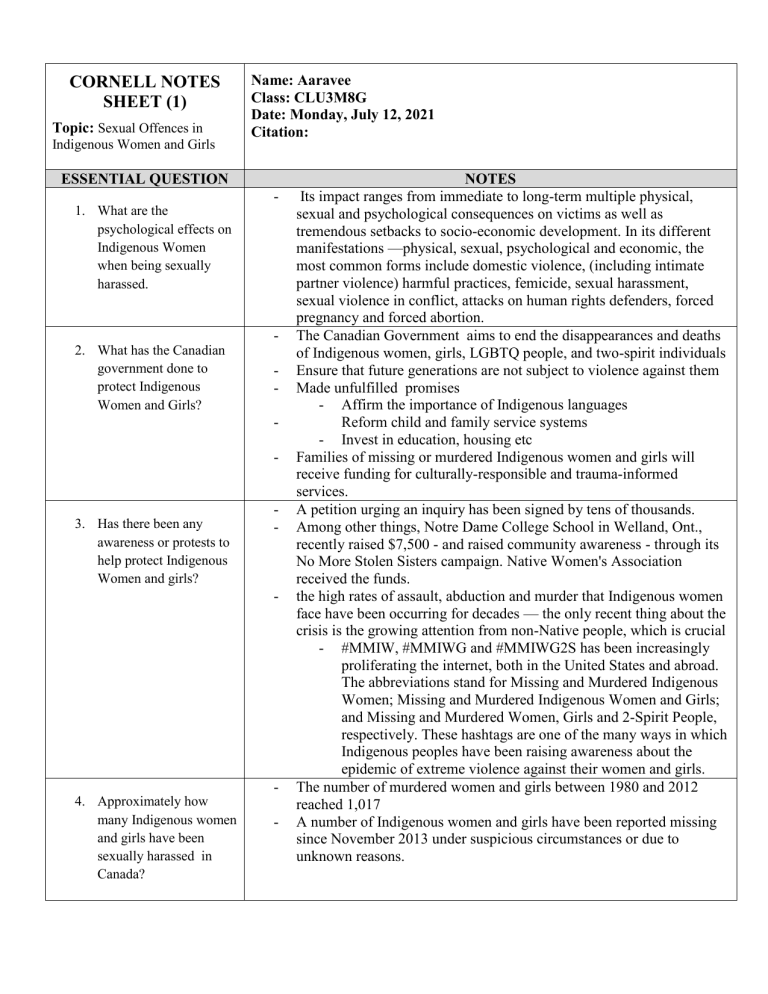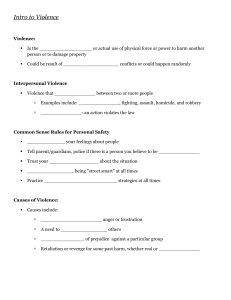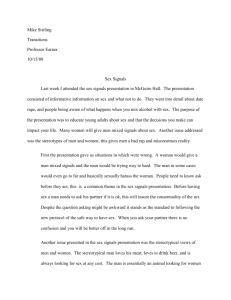
CORNELL NOTES
SHEET (1)
Topic: Sexual Offences in
Indigenous Women and Girls
Name: Aaravee
Class: CLU3M8G
Date: Monday, July 12, 2021
Citation:
ESSENTIAL QUESTION
1. What are the
psychological effects on
Indigenous Women
when being sexually
harassed.
2. What has the Canadian
government done to
protect Indigenous
Women and Girls?
-
3. Has there been any
awareness or protests to
help protect Indigenous
Women and girls?
-
-
4. Approximately how
many Indigenous women
and girls have been
sexually harassed in
Canada?
-
NOTES
Its impact ranges from immediate to long-term multiple physical,
sexual and psychological consequences on victims as well as
tremendous setbacks to socio-economic development. In its different
manifestations —physical, sexual, psychological and economic, the
most common forms include domestic violence, (including intimate
partner violence) harmful practices, femicide, sexual harassment,
sexual violence in conflict, attacks on human rights defenders, forced
pregnancy and forced abortion.
The Canadian Government aims to end the disappearances and deaths
of Indigenous women, girls, LGBTQ people, and two-spirit individuals
Ensure that future generations are not subject to violence against them
Made unfulfilled promises
- Affirm the importance of Indigenous languages
Reform child and family service systems
- Invest in education, housing etc
Families of missing or murdered Indigenous women and girls will
receive funding for culturally-responsible and trauma-informed
services.
A petition urging an inquiry has been signed by tens of thousands.
Among other things, Notre Dame College School in Welland, Ont.,
recently raised $7,500 - and raised community awareness - through its
No More Stolen Sisters campaign. Native Women's Association
received the funds.
the high rates of assault, abduction and murder that Indigenous women
face have been occurring for decades — the only recent thing about the
crisis is the growing attention from non-Native people, which is crucial
- #MMIW, #MMIWG and #MMIWG2S has been increasingly
proliferating the internet, both in the United States and abroad.
The abbreviations stand for Missing and Murdered Indigenous
Women; Missing and Murdered Indigenous Women and Girls;
and Missing and Murdered Women, Girls and 2-Spirit People,
respectively. These hashtags are one of the many ways in which
Indigenous peoples have been raising awareness about the
epidemic of extreme violence against their women and girls.
The number of murdered women and girls between 1980 and 2012
reached 1,017
A number of Indigenous women and girls have been reported missing
since November 2013 under suspicious circumstances or due to
unknown reasons.
5. What are the statistics
on Aboriginal women
being harassed?
-
-
-
6. Why don't they report
it to the police about
the assault?
-
-
-
-
7. What do they mean by
the “real rape?”
-
-
According to the 2014 General Social Survey (GSS) on Victimization
the rate of self-reported sexual assault of Indigenous people (58 per
1,000) was almost triple that of non-Indigenous people (20 per 1,000).
The rate of sexual assault self-reported by Indigenous women (113 per
1,000) was more than triple that of non-Indigenous women (35 per
1,000).
Rates of spousal assault against Aboriginal women are more than three
times higher than those against non-Aboriginal women. Nearly onequarter of Aboriginal women experienced some form of spousal
violence in the five years preceding the 2004 GSS.
There is a serious problem of sexual violence in Canada. The provinces
of Manitoba and Saskatchewan have the highest rates of sexual
violence reported to the police (Benoit, et al., 2015). According to
Conroy and Cotter (2017), 2.2% of Canadians have experienced a form
of sexual violence in their lives. In 2012, there were 21,900 incidents of
sexual assaults reported to police in Canada. Most of the victims tend to
be women, young, Aboriginal, single, homosexual, or bisexual (Conroy
& Cotter (2017). Most often, the sexual offender is a friend,
acquaintance, or a neighbor (Benoit et al., 2015; Conroy & Cotter,
2017).
In Saskatchewan, as in Northern British Columbia, Human Rights
Watch found evidence of a fractured relationship between law
enforcement and Indigenous communities. The legacy of settler
colonialism and racist assimilation policies—particularly the residential
school system—still overshadow the present-day dynamics between
police and Indigenous communities.
Residential schools, which the Canadian government operated up until
1994, along with the Catholic Church, forcibly removed Indigenous
children and youth from their communities, severing connections to
their kinship networks and family, language, and culture. Many
Indigenous children and youth in residential schools were also
subjected to severe psychological and sexual abuse while in these
facilities.
The RCMP was actively involved and complicit in ensuring that
Indigenous children attended these schools. This historical context fuels
the strong mistrust, suspicion, and resentment many Indigenous people
continue to feel towards law enforcement.
Sexual assaults reported to the police rarely result in conviction
(Rotenberg, 2017), often lack a thorough investigative process, and one
in five sexual assault reports are deemed unfounded (disbelieved) by
the police (Doolittle et al., 2017), with no further action taken. The
“unfounded” code is allocated to sexual assault cases that have been
deemed false or baseless by the police after a thorough investigation
A stereotypical “real rape” victim is one who is credible, assaulted with
a weapon by a stranger, and sustains physical injury (Quinlan, 2016;
Sleath & Bull, 2017). Sexual assault victims who are not believed by
the police often experience secondary victimization, and ultimately do
not attain justice for victimization (Patterson, 2011).
Police officers, prosecutors, and juries often cling to the stereotypical
image of "real" rape. In "real" rape, the crime consists of a forcible
attack, perpetrated by a male stranger on a female victim who has not
8. Where did the rape
culture come from or
originated?
-
-
-
9. What is the
perspective of the
Catholic Church's
teachings on rape?
-
-
-
-
been drinking or behaving in a sexually provocative manner, and is
immediately reported to law enforcement and supported by ample
physical evidence. Crimes that do not fit that stereotypical pattern are
often ignored by law enforcement or dropped by prosecutors who
believe — often correctly — that they will be rejected by juries.
- Stereotypes about what constitutes "real" rape affect the
definitions used in data gathering: if the crime is defined too
narrowly, then some rapes won't show up in the statistics.
Rape culture didn't come out of nowhere. It's the direct continuation of
centuries of patriarchal power and the institutions that developed to
support it.
When the US was founded, the powers that be — which is to say, men
— constructed a system in which women's rights were legally and
socially subordinate to men's. While justifications for this system were
often couched in morality and tradition and the need to "protect"
women, in implementation they were all about male power over
women.
In early US legal decisions, courts treated rape as a crime against a
woman's sexual purity, rather than as solely against her consent: a
complaining victim had to prove that she had "good character" in order
to pursue charges against her assailant. Second, the woman had to
prove that she physically resisted the attack; in the words of one New
York court in 1838, "she must resist until exhausted or overpowered,
for a jury to find that it was against her will." Many states also required
that the woman cry out for help and report the assault immediately in
order for it to be a prosecutable offense.
"Rape is the forcible violation of the sexual intimacy of another person.
It does injury to justice and charity. Rape deeply wounds the respect,
freedom, and physical and moral integrity to which every person has a
right. It causes grave damage that can mark the victim for life. It is
always an intrinsically evil act. Graver still is the rape of children
committed by parents (incest) or those responsible for the education of
the children entrusted to them." (no. 2356) Note that rape is "an
intrinsically evil act," meaning that it is evil at its very root, nothing
justifies it, and it is objectively a mortal sin.
“Rape is the forcible violation of the sexual intimacy of another person.
It does injury to justice and charity. Rape deeply wounds the respect,
freedom, and physical and moral integrity to which every person has a
right. It causes grave damage that can mark the victim for life. It is
always an intrinsically evil act. Graver still is the rape of children
committed by parents (incest) or those responsible for the education of
the children entrusted to them.” –Catechism of the Catholic Church,
#2365
It is always the rapist who is the one committing the sin of rape, by
definition. It is a sin perpetrated by one sinner against another person,
who is innocent of that sin. It is not the injured party who can cause
rape or who sins by the rapist’s sin.
The Catechism also provides examples of circumstances in which, in
addition to rape being a sin that seeks to dehumanize a child of God, it
can also be a sin of betrayal. This list could include situations where a
husband rapes his wife (yes, rape can and often does occur within
marriages), or when a teacher, policeman, doctor, priest or anyone else
in a position of power or authority abuses their position to sexually
exploit the powerless. Most rapes are not perpetrated against victims by
a stranger, but by someone that the victim knows and trusts. When this
happens, the grave sin of betrayal is added to the sin of rape.
2337 Chastity means the successful integration of sexuality within the person
and thus the inner unity of man in his bodily and spiritual being. Sexuality, in
which man’s belonging to the bodily and biological world is expressed,
becomes personal and truly human when it is integrated into the relationship
of one person to another, in the complete and lifelong mutual gift of a man and
a woman.
- The sin of rape perverts the very purpose of sexuality. Instead of a free
self-gift, it is an attempt to dominate and enslave by stealing the body
of another human being, made in the image and likeness of God. It is
diabolical in its warping of the purpose of the human body. To use a
metaphor, a person who forces sexual intimacy is like an iconoclast
who uses a statue of Mary to break the window of a Church. There is a
double character to the sacrilege, for the rapist not only harms and
violates the precious child of God, he debases his own body which was
also created as a temple of the Holy Spirit. For this reason, the Church
teaches, rape is a sin against chastity, against charity and also against
justice.
- 2338 The chaste person maintains the integrity of the powers of life and
love placed in him. This integrity ensures the unity of the person; it is
opposed to any behavior that would impair it. It tolerates neither a
double life nor duplicity in speech.
- A corollary of this is that the rapist, the unchaste person who abuses his
own body and violates another precious human being, destroys the
integrity of his life, commanded and intended by God. And it is thus
not surprising that rapists not only tolerate duplicity in their speech and
life, but strive to maintain their power through lies, manipulation, and
further abuses of power. From the Catechism, we can also deduce, that
the chaste person does not employ jokes about the heinous crime of
rape as an acceptable subject of mirth. There is nothing humorous
about the trauma and violation of a temple of the Holy Spirit. From this
we can also surmise that enablers of the sin of rape by negligence,
deceit, willful omission or positive affirmation or tolerance of the
crime, put themselves in grave spiritual danger and partake in
victimizing the vulnerable. Any profit or power gained by enabling this
foul exploitation of the vulnerable is likewise complicit in the sin.
10. What are the Hindu
teachings about rape?
-
-
The law books recognize the need for a happy family and a happy
household, in which the parents live in harmony with each other and
contribute to the promotion and preservation of dharma. They highlight
the importance of treating women with respect and honor as a part of a
householder’s obligatory duty. That duty begins from the very
childhood, when one receives initiation and becomes a student, and
continues until the end or until one takes up sanyasa or the vow of
renunciation.
To honor, protect and respect the women of the household, this indeed is
the onerous and obligatory duty of all men in each Hindu family. They
-
-
-
shall never put them to unnecessary suffering or neglect or dishonor. The
consequences of not doing it is fraught with terrible consequences for the
reputation and continuation of all involved. It may be noted that in the
very beginning of the Bhagavadgita, Arjuna expressed this concern to
Krishna and used it to justify his refusal to fight.
Women may not have the same status as men in many respects, but
they deserve to be treated well for their happiness and wellbeing and
those of the families they serve as participants in the observation of
dharma. References to it are found in the Manusmriti, (3.55-3.57)
which declares that “women must be honored and adorned by their
fathers, brothers, husbands, and brothers-in-law, those who desire (their
own) welfare. Where women are honored, there the gods are pleased;
but where they are not honored, no sacred rite yields rewards. Where
the female relations live in grief, the family soon wholly perishes; but
that family where they are not unhappy ever prospers.”
The law books recognize the vulnerability of women to violence and
abuse, and the fact that they are physically weak and mostly depend
upon their husbands and male members of the family for protection and
support. Hence, they put the onus of protecting women and girl
children upon men, especially the men of the households to which they
belong.
The importance of women’s honor in the affairs of men is also amply
conveyed in the epics namely the Ramayana and the Mahabharata.
Both are based upon the theme that disrespect, violence and aggression
against women lead to wars, strife, suffering and the downfall of those
who indulge in it. For example, in the first instance, Ravana abducted
Sita, resulting in a terrible war in which he ultimately perished. In the
second, in a display of revenge and treachery, the evil Kaurava brothers
tried to disrobe and publicly shame Draupadi, which deepened the
hostilities between the cousins and made the war of succession
unavoidable. The same theme is illustrated in the story of the impulsive
abduction of Amba by Bhishma. It caused two wars, and eventually led
to the death of Bhishma. Even gods honor the law of showing respect
and deference to women. They treat their consorts with respect and
generously allow them to have the final word in personal disputes to
keep them happy.
SUMMARY: Write 4 or more sentences describing specific learning from these notes.
Sexual Offences in Indigenous Women and Girls is a serious case that needs to be dealt with immediately. Its
impact on the victims ranges from immediate to long-term multiple physical, sexual and psychological
consequences on victims as well as tremendous setbacks to socio-economic development. Rape culture didn't
come out of nowhere. It's the direct continuation of centuries of patriarchal power and the institutions that
developed to support it. Simply put, this situation needs to be broadcast and heard around the world.




